
Latest News
- Hyundai E&C applies smart EV charging solution to apartment buildings for the first time
- Hyundai E&C wins one of the world’s top three design awards for four consecutive years
- Hyundai E&C Signs PPA for Solar Renewables with Glennmont D&D Solar Holdings
- Hyundai E&C to Embark on UK SMR Project forging Korea-US-UK Technology Alliance
- Hyundai E&C Consolidates Leading Position in Concrete Safety and Quality Technology
[Hyundai E&C Encyclopedia Vol.9] Transformation of useless waste! Eco-friendly energy, ‘Biogas’
![Biogas [Hyundai E&C Encyclopedia Vol.9] Eco-friendly energy created through waste, ‘Biogas’](/FileContents/EditorImg/20231220/표지_770(1).png)
Organic waste such as food waste that is being discarded in our daily lives, sewage residues that remain after purifying dirty water, and animal excretions are infinitely generated in our lives. Such waste would generate inconvenience in our lives if left unchecked because the waste would cause environmental issues. This is because the waste can act as the major root cause of climate crisis such as water contamination and stench in the process of decomposition. However, what would happen if such problematic organic waste became eco-friendly energy? Let me tell you the story of biogas.
History of transformation of organic waste
According to UN’s Food and Agriculture Organization, every year, approximately 1.3-billion-ton food waste is generated globally. As of 2021, Korea generated 5-million-ton food waste in a year, and this is an amount that can fill 1,260 20-story apartments. How about sewage waste? Every year, sewage residue that weighs approximately 4,144,617 ton is treated in Korea, and this can fill up about 828,923 5-ton trucks. In addition, animal excretions that weigh approximately 50,732,000 ton is generated in a year, and this is equivalent to 20,293 Olympic standard swimming pools (2,500m3).
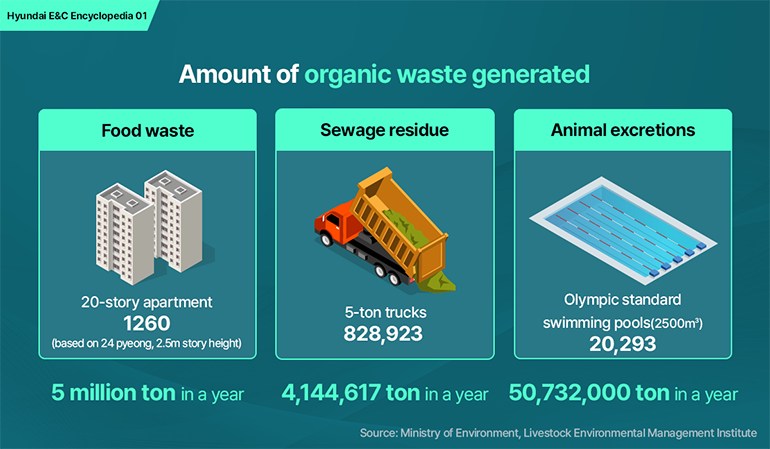
Treatment of organic waste is a global issue that needs to be resolved because there are many things to be considered such as an enormously high cost of treatment, hygiene and so forth. Since 2005, Korea prohibited food waste landfill, and starting with Seoul, food waste is disposed separately and being reused as animal feed or manure.
Furthermore, a large amount of waste water (food waste effluent) that is generated when processing food waste as feed or manure has a higher level of contamination than the leachate that is generated from general waste. Through the 2012 London Convention, food waste leachate is prohibited from being disposed to the ocean, and Korea also started to seek out alternatives such as incineration or sewage treatment by enforcing the prohibition measure in 2013.
Biogas that is receiving the spotlight as eco-friendly resource
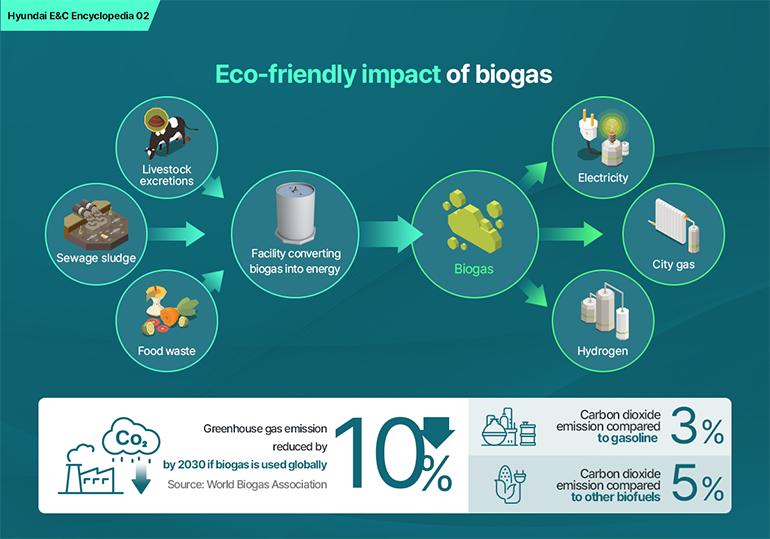
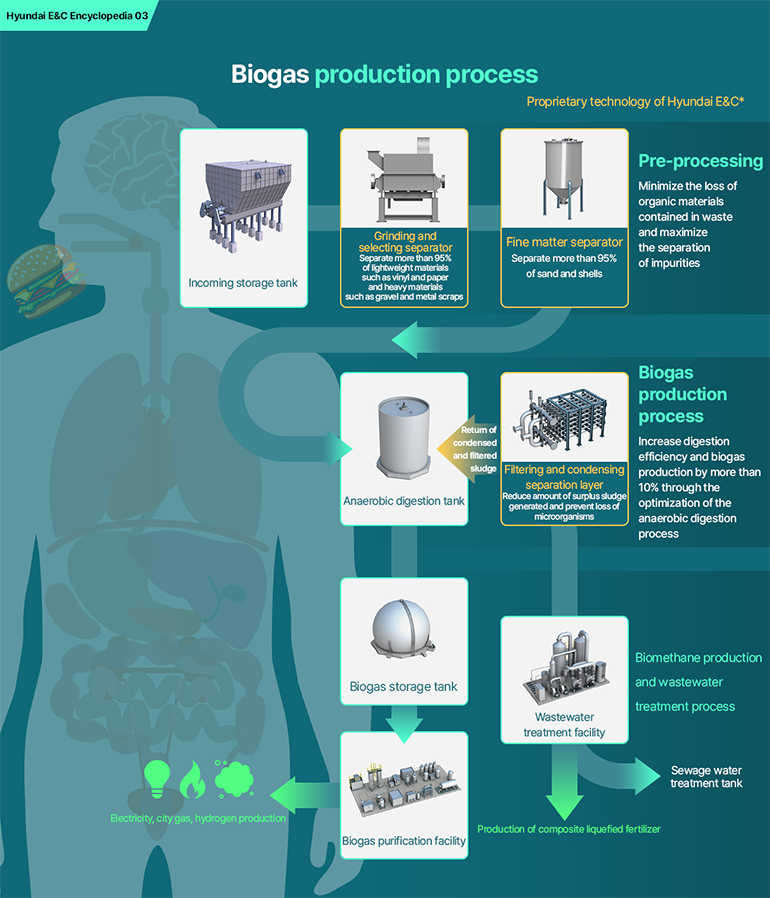
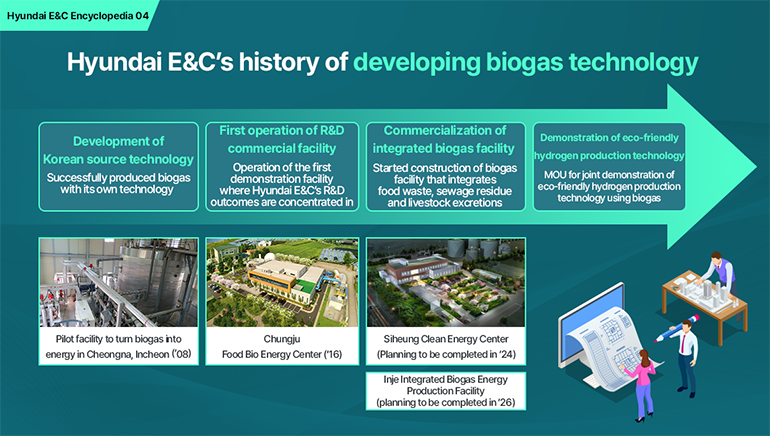

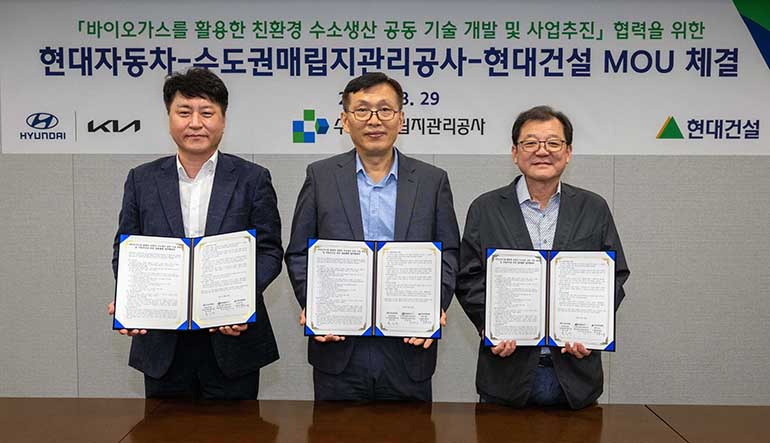
Biogas is made through fermentation and decomposition of waste such as food waste, sewage residue and excretions by microorganisms in an environment without oxygen. Biogas that is created through such processes go through purification and is used as energy source for hydrogen and so forth or is used as fuel of automobiles or city gas. Biogas mainly consists of methane (CH4) and carbon dioxide (CO2), and methane is an energy source with particularly great calorific power
Conversion of biogas into energy is an eco-friendly energy technology that uses various waste as renewable energy while stably treating waste and reducing greenhouse gas at the same time. According to the report published by the World Biogas Association (WBA), more than 105 ton of organic waste is generated globally every year, and if this is used as biogas, it will be able to reduce greenhouse gas emission by 10% by 2030.
Moreover, carbon dioxide that is emitted during the process of generating biogas is very low at 3% as compared to that of gasoline production, and it is only about 5% even when compared against other biofuels. It is also economic because cost of production is only about 1/5th of PV power generation. Furthermore, since carbon dioxide that is generated when digesting organic waste is also converted to biogas, it is a carbon neutral energy source where carbon dioxide emission is close to zero.

Process of the generation of biogas
The process of creating biogas is similar to the process of eating and digesting food. Food gets mixed with saliva in a person’s mouth, and breaks down. In a similar manner, organic waste that is gathered in the incoming storage tank* is ground and goes through an impurity screening process to become suitable for digestion. This is called the pre-process.
*Incoming storage tank: This is the space where food waste is first stored and waste is uniformly mixed and leachate is removed.
Just as the liquefied food moves to the digestive organ to be digested, pre-processed leachate that completes grinding and screening in the pre-processing facility undergoes fermentation and digestion in the anaerobic state as it goes through the anaerobic digestion tank*. Biogas is generated at this point. We can compare this to fart that comes out after digestion. During this process, the anaerobic digestion tank plays the role of the stomach and the colon of a person. Remaining waste water goes through the resource recovery waste treatment system to recover ammonia, and afterwards, composite liquid fertilizer would be generated. What remains after recovering nitrogen is transferred to the wastewater treatment facility.
*Anaerobic digestion tank: This is the space where waste is broken down into microorganisms in an anaerobic state to create biogas.
This is not the end. Biogas that is generated goes through another transformation. It is transferred to the desulfurization facility and the biogas storage tank to have the impurities removed. Once it goes through the process to covert the biogas to a high-quality biogas that separates out methane and carbon dioxide, biomethane with purity that is greater than 97% is finally produced. Biomethanes is used as city gas or automobile fuel, and it is also used for electricity or as the raw ingredient for hydrogen production. Carbon dioxide that is separated after making biomethane can be used in various manufacturing industries and agricultural industries.

Hyundai E&C’s history of developing biogas technology
The world is focusing on biogas to resolve the pan-global issue of greenhouse gas reduction. Biogas market is growing steadily while recording a compound annual growth rate (CAGR) of 9.2%. As mentioned before, Korea started to become interested in the production of biogas when food waste landfill was prohibited. However, at the early stage, when we had to depend on overseas technology, there were many challenges in the pre-processing due to the characteristic of Korean food that tend to be highly viscous and have a lot of liquid.
Hyundai E&C started to develop the source technology to turn biogas into energy to resolve this issue, and in 2008, it established a pilot facility for converting biogas into energy in Cheongna, Incheon to succeed in stably producing biogas after conducting a series of research. Based on the knowhows that were accumulated at the time, in 2016, it completed the construction of the Chungju Food Bio Energy Center that can undergo treatment of food waste that amounts to 80 ton in a day. Chungju Food Bio Energy Center that Hyundai E&C started operating solely with domestic technology is a demonstration facility where the outcome of Hyundai E&C’s R&D to convert organic waste resource into energy is concentrated in, and it is also being recognized as the leading model in Korea.
Hyundai E&C did not stop here, and is currently establishing the Shiheung Clean Energy Center that can integrate and process food waste, sewage residue and even excretions based on the technology that operated and validated the Chungju Bio Energy Center. The center that is planning to be completed in 2024 will integrate and convert organic waste resource that was treated in individual facilities until now into energy in a single facility, and hence, it can lead to saving operating cost in addition to the expansion of gas production amount. The amount of organic waste that can be treated in a day at Siheung Clean Energy Center is 540 ton of sewage residue, 145 ton of food waste and 60 ton of excretions.
Hyundai E&C is also spurring its efforts on research and development to upgrade its own technology. It won orders for the national initiative of Ministry of Environment in April, 2022, and it is planning to construct an integrated biogas energy production demonstration facility that can process 75 ton of livestock excretions, sewage residue and food waste in a day in Inje, Gangwon-do Province by 2026. ‘Inje Integrated Biogas Energy Production Facility’ that uses the enhanced pre-processing technology will contribute to the production of a greater amount of biogas in the future, and it is expected to consume less energy while stably treating wastewater.

Core biogas technology owned by Hyundai E&C
Hyundai E&C is continuing to develop innovative technology to convert biogas into energy through the enhancement of technology and continued research. Consequently, it obtained 2 certifications for new environmental technology and 1 green certification. It registered 15 patents in Korea and 3 patents in overseas to be recognized for its technological excellence. Let us take a closer look at the core technology of each process of Hyundai E&C that is optimizing biogas production by applying its own technology.
① Screening out even small sand granules! Selective separation of impurities in food waste
Pre-processing of food waste requires more detailed processes than the processes for livestock excretion of sewage residue. This is because fine matter such as sand, vinyl and paper in food waste that hinders biogas production has to be selected and separated to enhance the digestion efficiency and also minimize pump breakdown, blocked pipes and sedimentation in digestion tanks. Hyundai E&C’s proprietary pre-processing technology that can selectively separate impurities removes up to 95% of fine matter such as sand and shells, lightweight materials such as vinyl and paper and heavy materials such as gravel and metal scraps. This is the differentiated technology of Hyundai E&C.
② Anaerobic digestion technology that elevates the biogas production amount
The liquefied state of organic waste that went through pre-processing is called the pre-processing leachate. When pre-processing leachate goes through the anaerobic digestion tank to create biogas, recirculation processing process that is specialized to Hyundai E&C is added. This process can ultimately remove more than 80% of unnecessary volatile solid matter by minimizing the loss of microorganisms and increasing the retention time of sludge. This in turn enhances the biogas production amount by more than 10% as compared to the existing facility.
③ Strictly managing odor in each area! Stench removal technology
Since biogas is made from organic waste that causes odor, it is crucial to minimize the stench. Hyundai E&C developed a system that manages the stench concentration in real-time for the first time in Korea and adopted the technology in all biogas energy production facilities constructed by Hyundai E&C. Unlike the existing ventilation facilities that used to spread the odor into the air, stench is trapped through a closed-circuit structure, and negative pressure is maintained in line with the characteristics of each zone such as waste incoming tank, pre-processing room and waste treatment room to prevent the spread of stench. On top of this, hybrid stench capturing technology is applied in each zone that minimizes the stench leakage to protect the working environment of the employees. In addition, it can lead to the reduction of logistics cost and transportation cost because it can be installed nearby the city center.

Biogas that is emerging as the new energy of the future
Hyundai E&C is going one step further to take on the challenge to develop technology that extracts clean hydrogen with greater than 99.995% purity using biogas. Last August, Hyundai Motor Company, Kia Motors and Sudokwon Landfill Site Management Corporation signed an ‘MOU to carry out projects and jointly develop eco-friendly hydrogen production technology using biogas’ and will start the demonstration research to produce 216kg of eco-friendly hydrogen every day using biogas in earnest. We look forward to contributing to the establishment of a hydrogen ecosystem in Korea by expanding the production scope from biogas to electricity, city gas and even to hydrogen.

[ Hyundai E&C signed an MOU with Hyundai Motor Group and Sudokwon Landfill Site Management Corporation to jointly develop eco-friendly hydrogen production technology ]
It may still be unfamiliar to us, but biogas is certainly an eco-friendly energy that is gradually expanding its influential power as we usher in the carbon neutrality era. 25% of gas in the city is using biogas in Denmark, and per capita biogas generation in Germany is 15 times higher than that of Korea. Therefore, Korean government is planning to enforce obligation to produce biogas for organic waste resource (livestock excretion, sewage residue, food waste, and so forth) that is generated by each local government from 2025 based on the ‘Bill for the Promotion Act on the Production and Use of Biogas Using Organic Waste Resource’ that passed the plenary session of National Assembly in 2022.
Conversion of biogas into energy is not only helpful in recycling organic waste in each region, but it contributes to the enhancement of self-sufficient energy generation and will also play a critical role in strengthening energy security of Korea that is highly dependent on energy import. Hyundai E&C will stand at the forefront in realizing carbon neutrality and vitalizing resource circulation based on the unrivaled source technology that generates biogas.

